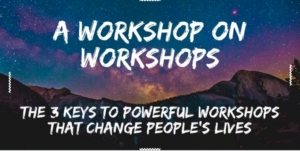What keeps an organization afloat? From my experiences directing a non-profit and running a small business, I’ve discovered that I depend on budget and buy-in — in other words, I need cash and people who care. Effective training for staff and supporters can positively impact both budget and buy-in. First, it can increase administrative efficiency, which saves time (and time is money!); second, it can fire up supporters’ passion, which boosts their commitment (and commitment can deliver both time and money!).
Training usually occurs within the context of a workshop. But despite the importance of effective training, I’ve found that most workshops are bad. Has that been your experience too? You know a bad workshop when you’re stuck in it. You may feel it bone-deep, coming up as sensations of intense boredom or profound frustration. Or you may observe it intellectually, noting such classic “bad workshop” indicators as:
- You haven’t moved or said a word for an extended period of time;
- The facilitator is spewing information that you could have just as easily read or watched on YouTube;
- You catch yourself thinking, “I’m losing hours of my life that I’ll never get back…”
I am declaring an end to bad workshops! From my studies and applied work, which include a doctoral dissertation in 21st century learning and over 15 years of teaching experience, I’ve identified 3 keys to powerful workshops that change people’s lives. Powerful workshops are NOT lectures — they’re playful, participatory, and practical experiences.
JUMP ON THE PHONE WITH ME NOW and let’s strategize how to enhance your upcoming workshop!
Here’s how I understand the 3 keys to powerful workshops:
- Playful
Good workshops are FUN.
A warm, upbeat atmosphere is a must. Research has found that this sort of context fuels creativity, boosts engagement, and facilitates relationship-building, all of which supports learning. To drive the fun factor, I suggest playing games and/or learning through play. Games and play lower the stakes around “failure,” allowing people to take risks without fear of losing face. In my dissertation, I describe playfulness as “where joy meets iteration.”
Good workshops are people-centered, celebrating the individuals in the room and honoring their human needs. What does this look like? Participants learn each other’s names and have the freedom to move their bodies, ask questions, make comments, crack jokes, and find comfortable spaces to work. Everyone’s experience is enriched by the presence of their peers.
- Participatory
Good workshops are HANDS-ON.
Now, we all have our preferred learning style. Some people excel when information is shared visually — they like to read text or scrutinize images that communicate big ideas. Others appreciate auditory information — they like to listen to explanations of how things work. Still others embrace kinesthetic information — they like to learn through doing. Sensitive instructors share information in all three of these ways, setting up every type of learner for success. But here’s a secret: A well-designed hands-on experience delivers a three-in-one.
When we engage in a well-designed hands-on experience, we learn through seeing, hearing, and doing. Additionally, we’re developing muscle memory and likely problem-solving, both of which helps us to better recall what to do and why. And isn’t that the point of a workshop — to teach us something we can use later?
- Practical
Good workshops are USEFUL.
While it can be fun to learn for learning’s sake, to immerse in a theoretical puzzle or toy with an abstract idea, that is not the stuff of workshops. Workshops should be goal-oriented, offering strategies that address real world challenges. For example, a staff workshop may focus on how to use office software. A supporter workshop may teach how to engage with your product in secret or sophisticated ways.
Good workshops meet participants where they’re at in terms of background knowledge and skill level, and provide participants with tangible products that further their objectives. Let’s say you want to teach staff how to use office software. If you put on a good workshop, then participants might walk away with: a printed packet with step-by-step directions and illustrative screenshots; a desktop shortcut to the application; a username and login; contact info for IT/support. Thanks to that good workshop, participants are equipped to hit the ground running.
Applying the 3 keys to your upcoming workshop can enrich your business or non-profit by positively impacting budgets and buy-in.
I wish you all the best with your upcoming workshop and invite you to CONTACT ME to discuss strategies for bringing your public speaking and/or facilitation to the next level!


